skip to main |
skip to sidebar
I'm normally alert to any railways I may encounter in my travels but the significance of the location for a business meeting at Felin Fawr near Bethesda on Tuesday 22nd August 2023 (described in the post here) had failed to register until my friend said "There's an abandoned railway out the back!". After the meeting here wasn't much time to explore, but I made sure of a few pictures to prompt further study later. This post reports what I found.
I knew that the meeting location was near Penrhyn Quarry, which was once the largest slate quarry in the world. But I didn't know that Felin Fawr was the processing site for slate and the building which had hosted my meeting was formerly a Slab Mill producing sawn slate for building purposes. There are useful Wikipedia articles on the slate industry in Wales, the quarry and Felin Fawr Slate Works.

Railway sidings at Felin Fawr in 2023. The meeting was located in the building on the left.
Slate from Penrhyn was used locally from the 16th century but development of the industry in the 1770s was due to Richard Pennant (see 'Notes on the Pennant family' below). Initially, slate was carried in panniers by horse down the mountain to the docks at Port Penrhyn for onward shipment.
Around 1800 the Penrhyn Railroad was constructed, using oval rails fitted at 2 foot and half an inch centre-to-centre, apparently incorporating the somewhat earlier Llandegai Tramway. Haulage was by horses and the most difficult sections were provided with inclined planes operated as a gravity balance cable railway with two tracks. A cable attached to an ascending empty wagon wound around a drum at the top of the incline and attached to a loaded wagon descending means no external power was required. Control was provided by braking on the drum.
In 1878 the operation was transferred to a new, parallel railway using steam locomotive haulage throughout. The inclined planes were eliminated by deviations in the route, increasing route length but easing the grades. Trackwork was conventional and track gauge (measured in the normal way, between inner edges of rails) became 1 foot 10 3/4 inches. In this form, as the Penrhyn Quarry Railway, the system operated until 1962. In 2012, enthusiasts reinstated the trackwork around Felin Fawr which I'd found on my visit. Various galas and operating days were held between 2012 and 2017 when, sadly, the initiative ceased.
Wikipedia has notes on the railways and various cable railways There's an excellent, detailed history of the Penrhyn Quarry Railway in posts by Roger Farnworth here and here.
I also found three interesting articles and photographs by Graham Stephen about the Felin Fawr site. The first clarifies the layout of the Slate Mill. The second shows what remained around 2012 of a waterwheel which powered the mill. The third shows the locomotive shed during the sadly short-lived attempt to restore the railway as a preserved line. The waterwheel was of the suspended pattern, built by De Winton of Caernarfon (who also supplied some of the early steam locomotives for the Penrhyn Quarry Railway). An article by Steve Mills for the Gloucestershire Society for Industrial Archaeology here outlines the advantages of suspension water wheels and rim gearing.

Former Penrhyn Quarry Railway 'Blanche' restored (and heavily modified) at Festiniog Railway (Photo: A.M.Hurrell, CC BY-SA 3.0)
Notes on the Pennant family
Thomas Pennant (died 1522) was the Abbot of Basingwerk Abbey, Holywell. His grandson Gifford Pennant became a successful sugar planter in Jamaica. On his death the profitable sugar plantations, worked by slave labour, passed to Gifford's son Edward Pennant (1672-1736) who further developed the holdings whilst rising in the Jamaican establishment. On Edward's death, the estates passed to his sons John, Samuel and Henry (with care provision for a fourth son). Despite the family wealth, life in Jamaica could be challenging and the three brothers returned to England, leaving the plantations to be administered by agents and entered English society. John Pennant became a successful Liverpool merchant. Liverpool was, of course, the port of entry for Jamaican sugar. Samuel and Henry died without heirs, leaving their estates to John. Through a partnership in the salt trade with Colonel Warburton John became interested in the medieval estate of Penrhyn which was part owned by Colonel Warburton's wife. John, with his second son Richard Pennant (1739-1808), started buying up the remainder of the Penrhyn estate. Richard Pennant's political career started in 1761 when he became the Member of Parliament for Petersfield but, when a vacancy arose in Liverpool in 1767 he was returned unopposed. He married Colonel Warburton's daughter Anne Susanna in 1767.
Upon the death of John Pennant in 1781, the Penrhyn estate effectively became reunited, Richard inheriting part from his father and the balance through his wife. He also became absentee owner of the sugar plantations in Jamaica. In the election of 1780 he lost his seat in the House of Commons and was subsequently created !st Baron Penrhyn in 1783. Because this new creation was an Irish peerage, he was not allowed to sit in the House of Lords but able to stand for the House of Commons, allowing him to regain the Liverpool seat in 1784. Richard spoke in the House of Commons about trade and Liverpool concerns and remained opposed to the abolition of slavery. He was an enthusiastic supporter of projects to develop his Welsh estates and created the massive Penrhyn quarry. Previously, individuals would pay the landowner for the right to extract slate which was brought out by packhorses. Richard created an industry where the landowner took control of extraction and transport, paying employees a wage. He expanded the market for slate by building Port Penrhyn, Bangor, connected to the quarry by horse-drawn railroad.
On Richard's death in 1808, since he had no children, his Baronetcy lapsed and the ownership of the estates passed to his second cousin provided he added 'Pennant' to his name, becoming George Hay Dawkins-Pennant (1764-1840). George married for the first time in 1807 and had two daughters. He continued to develop the Penrhyn estate and received government compensation for the freeing of his slaves when slavery was abolished. In 1833, his elder daughter and co-heiress Juliana Isabella Mary Dawkins-Pennant married a Grenadier Guards officer, Edward Gordon Douglas (1800-1886).
By Royal licence, Edward Gordon Douglas changed his name to Edward Douglas-Pennant, allowing him to inherit the Penrhyn estate from his wife's father, George. In 1866 Edward Douglas-Pennant was raised to the peerage in a second creation of the title Baron Penrhyn, this time as an 'English' peerage. Developments at Penrhyn quarry and the Penrhyn estates continued. By his first wife, Juliana Isabella Mary Dawkins-Pennant, he had two sons and three daughters. During the 1868 general election, 80 quarry workers declined to vote for the Baron's son George who, at that time, was pursuing a political career and were sacked. After the death of his first wife, the 1st Baron re-married and had further children
The 1st Baron died in 1886 and his elder son George Douglas-Pennant (1836-1907) became the 2nd Baron, thereafter concentrating on the running of the various businesses. Penrhyn quarry workers went on strike in 1896, leading to closure of the quarry for 11 months. The 2nd Baron was unrelenting and the strikers resumed work on the same terms. A second strike in 1900 lasted for three years, earning 'The Great Strike of Penrhyn' a special place in the history of the Trades Union Congress. The 2nd Baron was clearly a complex man of strong convictions, hinted at in the biography in the Dictionary of National Biography. After reading about the turbulence of the nineteenth century, I decided not to pursue the Pennant history into the 20th century.
Notes on Penrhyn Castle
Penrhyn Castle was clearly important to the Pennant family and although externally the castle gives the appearance of being ancient, it is not. Between 1822 and 1837, the architect Thomas Hopper (1776-1856) created the imposing appearance. The castle is regarded as his finest work and listed Grade 1. As a National Trust site, it is open to the public and the former Stables houses a railway museum including Penrhyn Quarry Railway artefacts. There's an article about the railway museum on Wikipedia here and there's an entertaining record of the railway museum activities written by one of the former museum volunteers, Keith Jaggers, here. There's lots more about the Jagger's family history and Keith's interest in railways here. Over 2,000 documents from Penrhyn Castle have been archived at Bangor University, providing a valuable insight into transatlantic slave trade and plantation slavery. Dr. Marian Gwyn has researched these areas and there's an interesting article by her outlining the connection between Penrhyn Castle and slavery here.
List of referenced posts on other websites
Slate Industry in Wales (Wikipedia).
Penrhyn Quarry (Wikipedia).
Felin Fawr Slate Works (Wikipedia).
Penrhyn Quarry Railway (Wikipedia).
Cable railway (Wikipedia).
Penrhyn Quarry Roger Farnworth: Penrhyn Quarry Railway (Part 1).
Penrhyn Quarry Roger Farnworth: Penrhyn Quarry Railway (Part 2).
Suspension water wheels and rim gearing
FELIN FAWR WORKS Graham Stephen (GeoTopoi).
FELIN FAWR WATERWHEEL Graham Stephen (GeoTopoi).
FELIN FAWR LOCOMOTIVE SHED Graham Stephen (GeoTopoi).
Richard Pennant, 1st Baron Penrhyn (Wikipedia).
George Hay Dawkins-Pennant (Wikipedia).
Edward Douglas-Pennant, 1st Baron Penrhyn (Wikipedia).
George Douglas-Pennant, 2nd Baron Penrhyn (Wikipedia).
The great Penrhyn quarry strike (TUC).
Dictionary of National Biography, 1912 supplement.
Penrhyn Castle (Wikipedia).
Thomas Hopper (architect of Penrhyn Castle) (Wikipedia).
Penrhyn Castle Railway Museum (Wikipedia).
Penrhyn Castle Railway Museum: Vol 2 (Keith Jaggers).
Keith and Elizabeth Jaggers Family Heritage.
Penrhyn Castle and Slavery (Dr. Marian Gwyn).
My pictures
My pictures at Felin Fawr Cyf (showing the reconstructed trackwork) are here.
On Monday 12th June 2023, I visited the former Nant Helen Opencast and associated Onllwyn Washery site (extending to 550 hectares) which is to become the Global Centre of Rail Excellence (GCRE) in South Wales to attend their 'Open Day'. I travelled by rail to Newport the previous day with an overnight stay in Newport (described here). before the 'Open Day' visit.
A liitle background
The geology of Wales gave the country massive deposits of coal and other minerals. Initially, early tramroads were used to assist extraction but the growth of steam power (in manufacturing, railways and steamships) increased demand and led to a series of railways being created. The Dulais Valley had a number of mines, giving rise to various local iron and copper works.
Over time, underground mining gave way to opencast mining. Excavators first remove topsoil which is taken away by large dump trucks (called 'Haulers') and stored in soil mounds to be reused when mining is complete. Excavators then remove the unwanted material ('overburden') to access the coal-bearing layers beneath, resulting in a large pit or void, equipped with a network of roads allowing the coal extracted by excavators to be hauled away. Remediation of areas once extraction ceases can start in some areas even as opencast mining continues in others.
Until 2022, coal from Nant Helen was loaded onto rail wagons at Onllwyn Washery and carried away using the former Neath and Brecon Railway. The refusal by the Coal Authority (a non-departmental public body sponsored by the Department for Energy Security and Net Zero) to issue a license for continued extraction forced closure of the mine and Washery and the railway was mothballed.
The Welsh Government, Powys County Council and Neath Port Talbot County Council developed an ambitious scheme to convert the Nant Helen site into a world-class test site for railway rolling stock and advanced railway infrastructure construction techniques called Global Centre for Rail Excellence (GCRE). GCRE will compete with existing facilities at Wildenrath, Velim and Old Dalby (Wikipedia)
The Open Day
Invitees to the open day were representatives from organisations who'd been involved in Innovate UK Phase 1 Bids at the site and were interested in bidding for further support on twelve projects during Phase 2 of this project. The meeting point was Onllwyn Welfare Hall (formerly Onllwyn Miners' Welfare Hall). After brief introductions given by GCRE staff, participants were divided into a number of parties to be escorted on a tour of the site using a fleet of Land Rovers. The site of GCRE is currently a building site where remediation work is being carried out using heavy plant, so the Construction (Design and Management) Regulations 2015, usually referred to as 'CDM Regs', apply requiring invitees to use full Personal Protective Equipment (PPE) during the tour.

GCRE: Onllwyn Welfare Hall, GCRE 'Open Day'
The Land Rovers were lined up in the car park outside the Welfare Hall and, once loaded, a short drive on public roads took us to the road overbridge where the currently-disused single-line railway from Neath enters the Nant Helen site near Onllwyn Washery.

GCRE: View from bridge over railway on Onllwyn Road, looking towards former Washery. Note trap points, operated from single-lever ground frame incorporating a keylock

GCRE: View from bridge over railway on Onllwyn Road, looking towards Neath. In the distance, note the level crossing on an internal site road formerly used by mining vehicles.
We then continued on a surfaced internal site road towards the offices of the former opencast complex.

GCRE: Land Rover Site Tour approaching offices/car park through land restored L: 1995-2000 R: 1980-1990

GCRE: Land Rover Site Tour passing the Offices/Car Park
We continued past the offices to the northern boundary of the site where we stopped to see the result of remediation work, including tree planting, carried out between 1993 and 1998.

GCRE: Land Rover Site Tour paused to show the land towards the north of the site restored between 1993 and 1998.
Looking north, there were impressive view towards the Brecon Beacons with Abercrave village in the foreground (served by the A4221 road hidden in the trees).
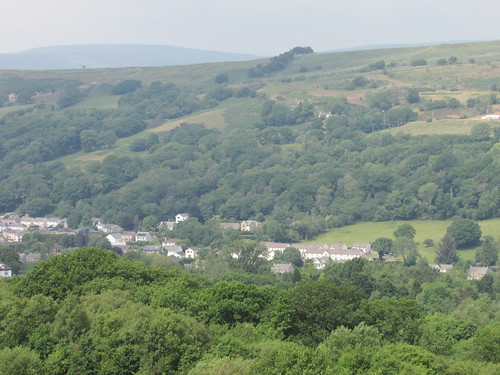
GCRE: Land Rover Site Tour showing Abercrave to the north of the site.
The Land Rovers returned to the office complex and turned west, past rows of parked heavy plant left and right and what I assumed were the vehicle maintenance workshops. From here, we continued on what had been named the Haul Road - a feature of mining sites where massive vehicles bring back the extracted material from the working face to a central point for processing or distribution. Some heavy plant was in use but many vehicles appeared to be in store. Presumably some of the plant previously used in the extraction of coal has been re-purposed for the ongoing remediation work.

GCRE: Land Rover Site Tour showing tracked excavators in store. They appear to be Komatsu PC 2000. CAT 'Dozers' are also parked
Our Land Rovers started to prove their worth as we entered a grey 'moonscape' where the surface, frequently wide enough for a motorway, had been rolled but not surfaced.
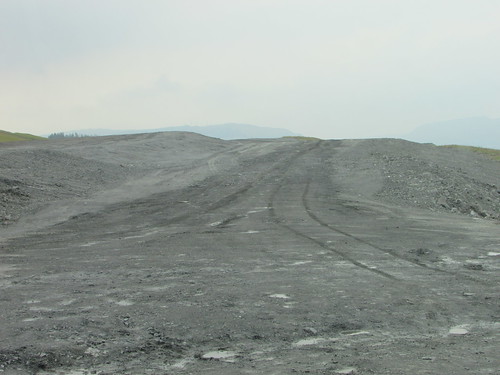
GCRE: Land Rover Site Tour on the Haul Road

GCRE: Land Rover Site Tour showing a 20-ton tracked excavator (JCB 220X LC) operated by Walters with a number of Volvo A30G Articulated Haulers parked
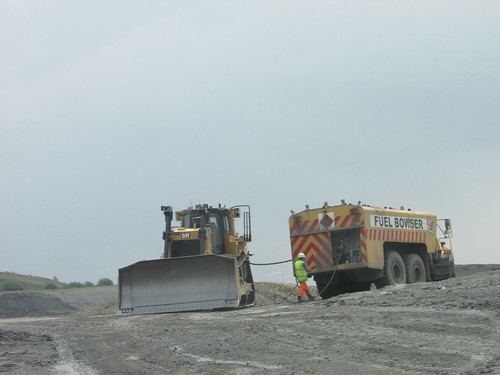
GCRE: Land Rover Site Tour on the Haul Road showing a CAT 'Medium Dozer' being refuelled from a Fuel Bowser

GCRE: Land Rover Site Tour passes a Volvo A30G Articulated Hauler ('Dump Truck') which can carry a 29 tonne net load
I was fascinated as we approached an unfamiliar-looking tracked machine being loaded onto a trailer. By the time we passed the scene, the machine had been left halfway up the trailer ramp. It appeared to be a drilling rig but, knowing nothing of groundworks, it took a little searching to conclude it was a Eijkelkamp Fraste CRS XL140 DUO multi-purpose sonic rig.

GCRE: Land Rover Site Tour on the Haul Road with plant at work and Drilling Rig about to be loaded onto low loader hauled by tractor

Eijkelkamp Fraste drilling rig: It appears to be a CRS XL140 DUO multi-purpose sonic rig (GCRE)
Mining operations had left a large Void and the tour paused to allow the appearance, somehat softened by remediation work and fringed by spruce trees, to be viewed.
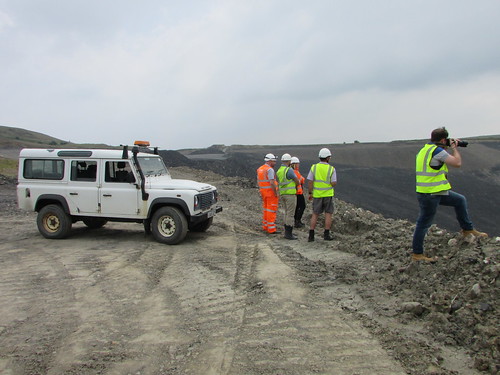
GCRE: Land Rover Site Tour paused to view the Void

GCRE: Land Rover Site Tour at The Void
At the highest point on the site, we passed a battered-looking self-supporting telescopic antenna which had been used for site communication using hand portables or private mobile radios.

GCRE: Land Rover Site Tour passes a rather battered transmission tower which supported site communications
The Land Rovers then returned us to the Welfare Hall for welcome refreshments.

GCRE: Onllwyn Welfare Hall, GCRE 'Open Day'
In the afternoon, we had a walking tour, proceeding on foot to the railway bridge on Onllwyn Road. After some discussion regarding the planned work to renew the rusting structure and adjust the railway track level, we took the internal site road to the level crossing on the Neath site of the bridge. It looked as if the level crossing and associated site roads had been provided to allow heavy road traffic from the mine to reach the Washery without crossing the rather fragile-looking road bridge.
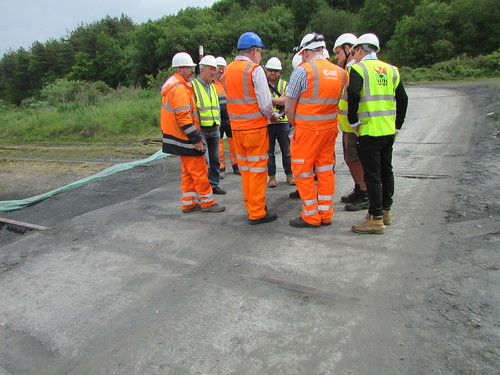
GCRE: Washery-Depot Area Walking Tour, GCRE Open Day, showing party joining the branch line at the level crossing
The tour continued along the railway track towards the Washery, passing under the Onllwyn Road bridge.

GCRE: Washery-Depot Area Walking Tour, GCRE Open Day, showing Onllwyn Road bridge with stone-built pediments.
We passed the original trap points, operated from a key-locked single-lever ground frame, which controlled movements from the Washery area onto the single line to Neath. Two original turnouts remain, as the single line fans out, but further on all permanent way has been lifted with a few panels of track neatly piled.

GCRE: Washery-Depot Area Walking Tour, GCRE Open Day, showing two turnouts and stop block. Note spare track panels in background.
Beyond here, the original sidings have been lifted and earthworks have been carried out, leaving a solitary abandoned CCTV camera (fitted in what appears to be a Dennard pan and tilt housing with windscreen wiper).

GCRE: Washery-Depot Area Walking Tour, GCRE Open Day, showing abandoned CCTV camera. Note tripod for surveying equipment in background.
Although the walking had tired me, it was disappointing that we didn't go further into the Washery area but instead cut through a car park near the security building and site entrance from Onllwyn Road to regain the public road and return to the Welfare Hall.
An unusual and absorbing visit.
Introduction to other Test Centres on other websites
Wegberg-Wildenrath Test and Validation Centre (Wikipedia)
Velim test centre (Wikipedia)
VUZ TEST CENTRE VELIM
Old Dalby Test Track (Wikipedia)
The Old Dalby Test Track
Related articles on other websites
History of Onllwyn Collieries (Welsh Coal Mines)
Global Centre for Rail Excellence (Wikipedia)
Eijkelkamp Fraste CRS XL140 DUO
Coal Authority (Wikipedia)
Related posts on this website
By Train to Newport (Getting to Wales for the Open Day)
My pictures
GCRE.
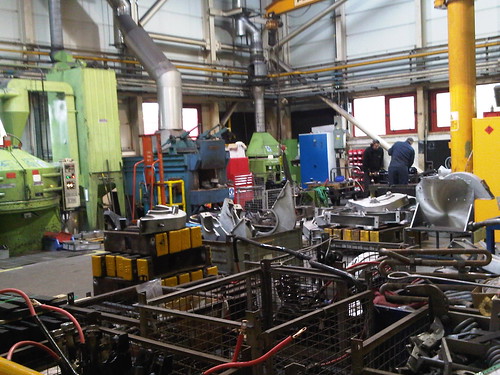
One corner of the Railway Engineering Works at Acton
Crewe, Swindon, Doncaster, Eastleigh, Acton - Acton? Perhaps Acton isn't one of the more famous railway works but London Underground established an important works at Acton. Mass transit sysytems are very intensively used and maintenance of rolling stock and infrastructure to the highest standards is essential.
My interest in Acton Works only started around 1995 when my firm became involved in work for London Underground, as described in the post London Underground and Jan. To be allowed 'behind the scenes' on any railway requires induction, safety training and various examinations matching the roles to be undertaken. An undergound fourth-rail electrified railway has particular risks and London Underground had a well-developed set of in-house training courses based at a Technical Training Centre at Acton Works. So I became a fairly regular visitor to Acton Works as I obtained different certifications and periodic re-certifications in connection with our work supplying Tunnel Telephone equipment, initially for the Jubilee Line Extension project and later for other London Underground lines. During these training visits, I saw glimpses of the work carried out around the sprawling Acton site, a mixture of old, modern and relocatable buildings.
Visits in 2006
During visits to REW Acton in connection with the design and supply of Tunnel Telephone equipment for a new installation at White City (necessitated by major changes to the London Underground depot in connection with the building of Westfield London Shopping Centre), I was able to take pictures of the external Signalling Training Facility that had previously intrigued me. Nearer the original Bollo Lane entrance to the site, a large concrete base provided with a fabric roof mounted an array of full-size working signalling equipment, including signals (colour light and disc shunting), point machines and train stops. On London Underground, points and train stops are electrically controlled but use compressed air to provide power, so the normal features of an air main running alongside the track provided with electro-pneumatic controls were also fitted. This allowing Signalling Technicians to receive training in maintenance of the various types of equipment in use on London Underground in a realistic environment supplementing training given in the adjacent Signal Training School, a large relocatable building provided with examples of various types of control system.

Signal Training facility, Bollo Lane, Acton with a variety of signals and air-operated points. The air main and control cables are along both sides, carried on posts.
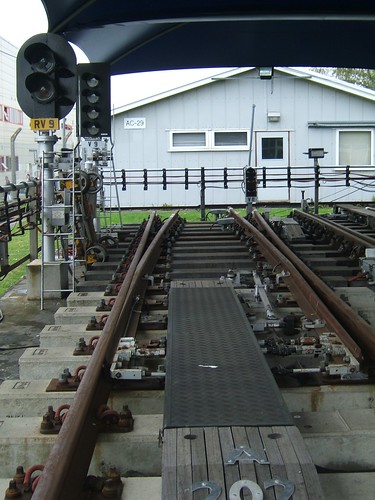
View in opposite direction of Signal Training facility. Left: Colour light signals Right: Turnout. The gabled building in the background is the Signal Training School.
Tour in 2011
During another business visit in March 2011, one of the London Underground staff arranged a fascinating, although brief, tour of part of the works. There wasn't time to get a proper understanding of the variety of work undertaken but I quickly realised the expertise available on the site. Below is a small selection of the things I saw.
Repair and refurbishment of rolling stock equipment forms a vital part of the work. In the reception area of one modern building, a part-sectioned motor wheelset for 1983 tube stock and part-sectioned gearbox for 92 tube stock were displayed.

Motor Wheelset for 1983 tube stock (part sectioned) on display at REW Trains Division, Acton.
In the Traction Motor Section of the works, rows of motors were being processed.

Traction motor section, REW Acton
Nearby, a series of massive jigs were provided for working on the pre-wired underbody control sub-assemblies.

Underbody control sub-assembly, mounted on jig.
Various signalling equipment is maintained at Acton, including heavy items like trainstops and various types of electro-mechanical relays.

Trainstop complete assembly, REW Acton

Shop for re-certifying electro-mechanical signalling relays (REW Acton)
I hadn't realised that surface-mounted cables feeding signalling equipment were normally pre-fabricated in standard lengths including moulded terminations, minimising time-to-exchange when replacement was necessary. I think these cables were bought-in complete but REW Acton also acts as a central stores for London Underground.

Prefabricated multicore cable for signalling showing moulded termination for fast connection to 12 terminal posts (REW Acton)
On an intensive mass transit system, every minute counts and London Underground has always provided clocks on stations to assist passengers and staff. But I was still surprised by the variety of clocks being repaired and regulated in the Clock Section. At the time of my tour, London Underground still had a few mechanical clocks at stations requiring weekly visits for winding!

The Clock Section (REW Acton)
Redundant D78 vehicles
During my 2011 visits, I saw a redundant D78 vehicle leaving the works on a low-loader. At the time, I thought the coach was going for scrap but I discovered afterwards these trains had been bought by Vivarail for conversion into modern, lightweight diesel-electric units for use on heavy-rail infrastructure. I caught up with these former D78 vehicles on a visit in 2018 to Quinton Rail Technology Centre (there's a post on that visit here).

Redundant D78 vehicle leaving REW Acton on low-loader in 2011.
My pictures
Pictures at REW Acton.
Books
There's a book on Acton Works titled ‘Underground Train Overhaul – The Story of Acton Works’ by J. Graeme Bruce/Piers Connor, published by Capital Transport Publishing in 1991 (ISBN 1 85414 134 1).
 'Traditional' methods of cargo handling still in use on the quayside
'Traditional' methods of cargo handling still in use on the quayside
in Sittwe, Myanmar.
Background
International shipping has always been important to trade but, within the last century, methods have been revolutionised by the introduction of standardised shipping containers ('containerisation') which replaced traditional cargo handling a piece at a time ('break-bulk cargo'). The enterprising North American haulier Malcolm McLean (1913-2001) accelerated this process in the 1950s. Effective designs by mechanical engineer Keith Tantlinger (1919-2011) allowed Freuhauf to build demountable shipping containers for McLean (Freuhauf invented the road trailer for motor trucks under the leadership of Augustus Freuhauf. The long and ultimately chequered history of Freuhauf is detailed by the Freuhauf Trailer Historical Society here).
McLean patented his designs, but gave a royalty-free license to the International Standards Organisation and the success of the innovation allowed goods to be efficiently moved around the world. There are Wikipedia articles about containerisation here and the containers used here. The most common containers are 20 feet or 40 feet long but shorter, longer and taller ('hi-cube') patterns are also used. Various special-purpose containers are provided either for carrying bulk liquids in tanks or products requiring refrigeration. The latter, called 'reefers', have built-in chilling equipment and loaded containers need external electric power to be connected whilst in storage or transit.
The success of the system was founded on the simplicity and reliability of the Twistlocks used in handling and securing containers - each container has eight Twistlock corner castings (4 on top, 4 underneath) which mate with either the handling crane, carrying vehicle (road trailer, rail vehicle or ship) or separate 'mid-locks' (allowing containers to be stacked). The need for manual labour was dramatically reduced and theft of cargo, whilst not eliminated, became a much more sophisticated crime. Road lorries could transport containers directly to or from the consignee or to a shipping agent who could ‘stuff’ or ‘strip’ part container loads. So, in docks all over the world, huge areas were concreted over to provide access for the container lorries and storage for the shipping containers coming and going.
The efficiency of container ships for intercontinental transport led to continuous increases in size of these vessels to reduce shipping costs. The size of ships that can pass through the major canals of the world (notably the Panama and Suez) sets the upper limit for ship dimensions. There's a clear explanation of the terms 'Panamax', 'Post-Panamax' and 'Panamax New' in Wikipedia here. A rough idea of the capacity of container ships is given by the 'TEU' - 'Twenty-foot equivalent unit', dscribed in Wikipedia here. Large container ships now have a capacity of 23,000 TEU.
Panama Canal
In 2008, I made a 'Partial Transit' of the Panama Canal, which is described here, with some additional information in the post The Panama Canal Railway. An additional set of larger locks opened in 2016, allowing ships up to 'Panamax New' to be handled - see the Wikipedia article here.
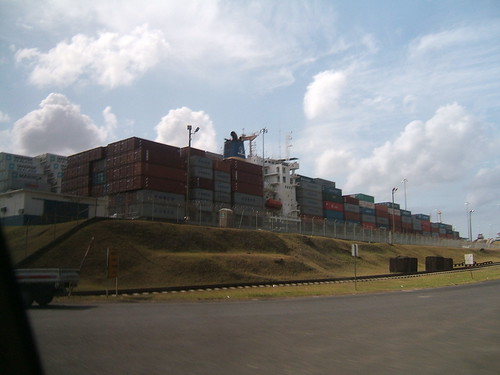
Container ship in Gatun Locks, Panama Canal
Suez Canal
I visited the lock-free Suez Canal in 2009, as described in the post Canal Zone, Egypt.

Maersk Line 'Sealand Slings' with deck container stacks 6-high in places heading north on the Suez Canal
Intermodal transport
Whilst massive container ships can economically move goods large distances, docking requires deepwater berths with specialist handling equipment so getting to the final destination usually requires transhipment to other transport modes - road, rail or sometimes smaller ships.
The significance of road trailers for motor trucks was mentioned in 'Background' above. Although local arrangements vary in different countries, articulated flatbed trucks for containers are a familiar sight. The Wikepedia article here gives a useful survey (and explains the various terms used to describe these vehicles).
But railways have been able to capture part of this market, moving containers between ports and inland distribution centres, from where final delivery may be by road. In the U.K. Freightliner offer over 37 direct routes between sea ports at Felixstowe, Southampton, Tilbury, London Gateway and Seaforth connected to 'major conurbations'.

Bournemouth by Train: View from Winchester platform 2, showing Up 'Freightliner' train passing.
At these terminals, rail-mounted goliath gantry cranes transfer containers to and from trains of special flat bogie wagons. The cranes are tailored to each site and many were constructed by famous bridge builders Sir William Arrol (who became Clarke Chapman in 1969). Freightliner describe the Seaforth (Liverpool) crane as follows:-
Terminal Crane Arrol 2-5-2 with with two cantilver outreaches built 1969. Specifically designed to load ISO containers on/off rail wagons stabled within the span of the crane and road wagons under one cantilver, the other cantilever used for the storage of containers. Rail span: 23.05m. S.W.L. under twistlocks: 32.0 tonnes. Lifting capacity: 20, 30, 40 and 45 foot containers at 13 lifts per hour.
Lawley Street, Birmingham, is an example of an 'inland port' or distribution centre.

Part of Lawley Street container depot.
Where containers are to be on- and off-loaded at destinations with fewer facilities, smaller ships (frequently provided with cranes on the vessel) are used.

View from the bridge of 'RMS St. Helena' en route from Cape Town to St. Helena, showing containers. The white-painted containers are 'reefers'. Note the two container-handling cranes in the 'stowed' position.
In my travels, I've seen a number of sea ports around the world modernised for handling shipping containers and a selection is illustrated below.
Liverpool
Liverpool and its docks have always fascinated me and many of my posts with the label Merseyside talk about docks and shipping on the River Mersey. Formerly operated by The Mersey Docks and Harbour Board, the docks are now run by Peel Ports whose website on its Liverpool facilities is here (and contains lots of interesting information, including data sheets for all the ship handling tugs operating on the Mersey).
In 1971, Seaforth Dock at the northern end of Liverpool Docks opened, with its group of strange-looking container-handling cranes for loading and unloading specialist container ships. This rendered many of the older docks redundant.There's a Wikipedia article here and an interesting aerial photograph by 'fragglehunter' here
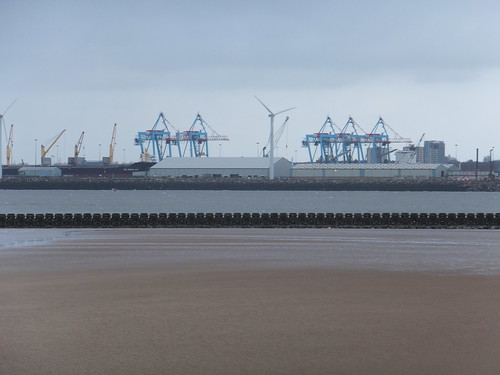 Royal Seaforth Dock seen from New Brighton.
Royal Seaforth Dock seen from New Brighton.
Peel Ports completed phase 1 of the new deepwater container port 'Liverpool2' in 2017, ultimately capable of handling two 380m-long 'Panamax New' vessels simultaneously - see the Wikipedia article here.

New Brighton by rail: View of Liverpool2 Dock from New Brighton, showing 4 of the 5 phase 1 container cranes with a group of young people in wet-suits on the beach.
There are two collections of my pictures showing Liverpool and Liverpool Docks
Southampton
I've visited Southampton a number of times over the years, but the pictures below are both taken from a train on a trip to Bournmouth in 2019 (described here. The Western Docks at Southampton now form a container port. The largest berth DP5, served by 5 container cranes, can accommodate 'Post-Panamax' vessels such as the 20,000 TEU 'MOL TRIUMPH' shown below.

Bournemouth by Train: View of DP World berth DP5 at Southampton after passing Millbrook station. The ship is MOL TRIUMPH.

Bournemouth by Train: View of DP World container cranes at berths DP1 to 4 at Southampton with Freightliner container crane in foreground. Note the 'Hoyer' tank container.
Yangon, Myanmar
In 2014, I walked along Strand Road, to see what was visible of the enclosed docks, as described here).
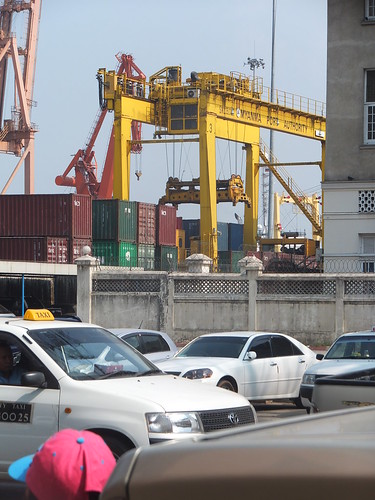
Yellow-painted Container Crane, showing the container-handling 'spreader' suspended from lifting cables, adjacent to Strand Road, Yangon, Myanmar.
Auckland, New Zealand
On the 'Tropic of Capricorn' trip early in 2020 (described here, I saw Auckland docks from both land and sea.
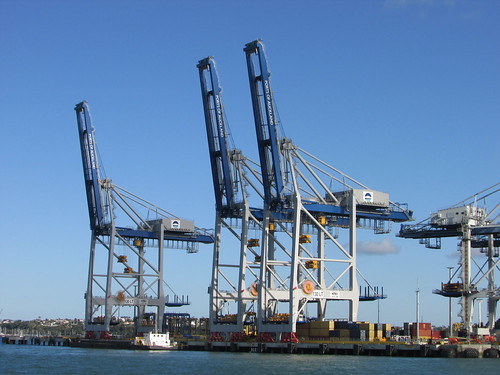
Container cranes on Fergusson Wharf, Auckland viewed from 'Caledonian Sky' (Tropic of Capricorn)
Haydarpasa (Istanbul), Turkey
Whilst exploring Istanbul's ferries in 2018 (described here, I saw the container port at Haydarpasa.
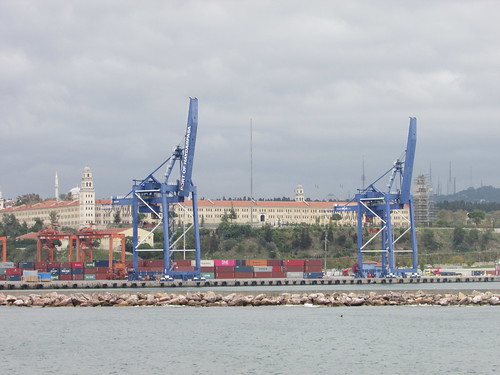
Port of Haydarpasa (Asian side) with two blue-painted container cranes and orange Straddle Cranes. In the background, the massive Selimiye Barracks (Istanbul's Ferries: Eminonu - Kadikoy).
Valparaiso, Chile
In 2016, a cruise to visit the Chilean fjords and the Antarctic Peninsula embarked from Valparaiso. The departure is described in the post 'Silver Explorer'
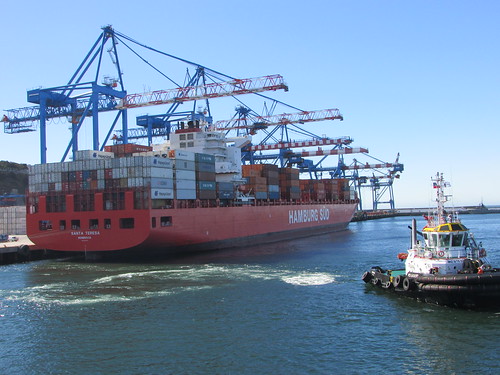
Container terminal, Valparaiso with Hapag-Lloyd container ship ‘Santa Teresa’.
Books
[1] 'Deep Sea and Foreign Going - Inside Shipping, the Invisible Industry that Brings You 90% of Everything' by Rose George, published by Portobello Books (ISBN: 078 1 84627 299 8).
[2] 'The Box: how the shipping container made the world smaller and the world economy bigger' by Marc Levinson, published by Princeton University Press (ISBN: 978-0-691-13640-0).
In February 2020, just before the Coronavirus pandemic transformed everybody's lives, I sailed on 'Caledonian Sky' for the second time on a Noble Caledonia cruise titled 'Across the Tropic of Capricorn' which is chronicled in a series of posts. Clicking here displays all these posts in reverse date-of-posting order or alternately, to read the posts in chronological order, clicking here displays the first post and then follow the link to the next post.
I'd first sailed on 'Caledonian Sky' in 2015, on a cruise titled 'From the Coral Sea to the South China Sea' which gave rise to a series of posts labelled 'Caledonian Sky’.
Clicking here displays all these posts in reverse date-of-posting order.The post here describes itself as "more than you wanted to know about the ship", but note that I don't know what changes may have occurred during the subsequent refit of the ship. Another post from that cruise here describes various visits to the bridge and one visit to the Engine Control Room during that trip.

A visit to the Engine Control Room of 'Caledonian Sky' in 2015.
During my second cruise on 'Caledonian Sky' in 2020, there was still an 'Open Bridge' policy, and I made three visits. On 15th February, we were on our way to the island of Tanna, in Vanuatu.

On autopilot, heading for Tanna, on 15-Feb-2020 ('Caledonian Sky' Bridge 2020)
When I returned to the bridge on 24th February, we were heading for Rabaul on East New Britain (part of Papua New Guinea).

ECDIS screen as we head through St. Georges Channel heading for Rabaul ('Caledonian Sky' Bridge 2020).
My last visit was on 26th February, as we made our way towards Port Moresby (Papua New Guinea). As usual, we were on autopilot, with a least one person keeping watch. Suddenly, the calm was broken by three different electronic alarms wailing. I tucked myself in a corner of the bridge, hoping they wouldn't decide to clear the bridge. First, they silenced the noisy alarms. Then, I noticed that the 'swish' of the air conditioning had ceased and that certain indicators had gone blank, so I assumed some sort of power failure.

"Some of the indicators had gone blank" 'Caledonian Sky' Bridge 2020.
There were a few telephone calls and other crew members arrived, including the Captain but the usual air of studied calm continued. The only real change was that one of the crew moved to the Anschutz autopilot console and controlled the small 'conning wheel' whilst carefully studying the heading display so I assumed we were temporarily under manual control.

'Caledonian Sky' Bridge 2020 with the ship being steered manually from the Anschutz autopilot console on the right.
After a few minutes of murmured conversation and more phone calls, we were clearly back on autopilot and the crew member abandoned his position by the 'conning wheel'. The air conditioning restarted and the Captain retired to his cabin, a few yards away. The incident was over.
My pictures
'Caledonian Sky' Bridge (2015).
'Caledonian Sky' Bridge 2020.
Engine Control Room, 'Caledonian Sky' (2015).






















































